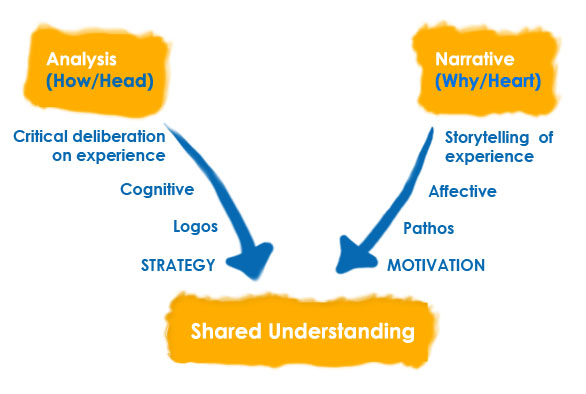I’m always on the lookout for ways to apply storytelling to job search and career. Here are a few I’ve encountered recently:
An article on the (Bill) Moyers & Company site by, I believe, Marshall  Ganz, is aimed at how organizers of social movements can tell their stories. But the article offers great advice to job-seekers, too. The author states, “A story of self tells why we have been called to serve. It expresses the values or experiences that call each person to take leadership on a given issue.” (The graphic shows how “the key to storytelling is understanding that values inspire action through emotion. We experience our values emotionally — they are what actually move us to act. Because stories allow us to express our values not as abstract principles, but as lived experience, they have the power to move others to action as well.”)
Ganz, is aimed at how organizers of social movements can tell their stories. But the article offers great advice to job-seekers, too. The author states, “A story of self tells why we have been called to serve. It expresses the values or experiences that call each person to take leadership on a given issue.” (The graphic shows how “the key to storytelling is understanding that values inspire action through emotion. We experience our values emotionally — they are what actually move us to act. Because stories allow us to express our values not as abstract principles, but as lived experience, they have the power to move others to action as well.”)
The same can be said about why we do our jobs and progress in our careers. The author goes on to talk about “choice points: moments in our lives when values are formed because of a need to choose in the face of great uncertainty.”
The author’s story structure focused on choice points is analogous the the many variations on story structures for job-seekers that go something like: Situation –> Action –> Result.
In this case, the formula is Challenge —> Choice —> Outcome.
For the most part the questions the author recommends around this structure are completely appropriate for constructing stories a job-seeker can use in an interview or even a resume or cover letter:
Challenge: What was the specific challenge you faced? Why did you feel it was a challenge? What was so challenging about it? Why was it your challenge?
Choice: What was the specific choice you made? Why did you make the choice you did? Where did you get the courage (or not)? Where did you get the hope (or not)? How did it feel?
Outcome: What happened as a result of your choice? What hope can it give us? How did the outcome feel? Why did it feel that way? What did it teach you? What do you want to teach us? How do you want us to feel?
I’ve long advised job-seekers that they don’t have to collect a massive number of stories to respond to interview questions because a single story can be manipulated in response to a multitude of questions. Ten stories is a good number to shoot for, but you can get by with seven, five, or even three (see my Three Success Stories exercise handout), as Rebecca Thorman affirmed in a recent article:
Instead of trying to prepare 50 answers for 50 different possible interview questions, go through your résumé and cover letter and pick three key work experiences that you’re proud of and that illustrate your relevant skills, experience and lessons learned. … By exploring a few stories from your past, you don’t have to worry about memorizing all the right answers to a myriad of potential questions.
 A case study is essentially a story. Branding expert Dan Schawbel advises using case studies to advance one’s career – in other words, stories of your experience and accomplishments. But what if you don’t have much experience, or it’s in the wrong field?
A case study is essentially a story. Branding expert Dan Schawbel advises using case studies to advance one’s career – in other words, stories of your experience and accomplishments. But what if you don’t have much experience, or it’s in the wrong field?
“When you have no experience or are looking to make a career change,” Schawbel writes, “using yourself as a case study is one strategy that can bail you out and help you form a foundation to build on.” If you don’t have the experience or the right experience, he says, “do what you would be doing for a company for yourself first.”
Schawbel, for example, designed Web sites for his own interests while in college and then used case studies of those creations to obtain clients.
To advance your career, sometimes, you need to not only tell your story in the form of a case study but create the story to tell.
